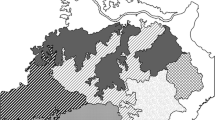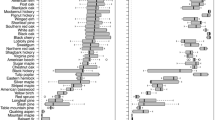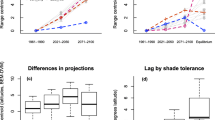Abstract
Context
Species distribution models (SDM) establish statistical relationships between the current distribution of species and key attributes whereas process-based models simulate ecosystem and tree species dynamics based on representations of physical and biological processes. TreeAtlas, which uses DISTRIB SDM, and Linkages and LANDIS PRO, process-based ecosystem and landscape models, respectively, were used concurrently on four regional climate change assessments in the eastern Unites States.
Objectives
We compared predictions for 30 species from TreeAtlas, Linkages, and LANDIS PRO, using two climate change scenarios on four regions, to derive a more robust assessment of species change in response to climate change.
Methods
We calculated the ratio of future importance or biomass to current for each species, then compared agreement among models by species, region, and climate scenario using change classes, an ordinal agreement score, spearman rank correlations, and model averaged change ratios.
Results
Comparisons indicated high agreement for many species, especially northern species modeled to lose habitat. TreeAtlas and Linkages agreed the most but each also agreed with many species outputs from LANDIS PRO, particularly when succession within LANDIS PRO was simulated to 2300. A geographic analysis showed that a simple difference (in latitude degrees) of the weighted mean center of a species distribution versus the geographic center of the region of interest provides an initial estimate for the species’ potential to gain, lose, or remain stable under climate change.
Conclusions
This analysis of multiple models provides a useful approach to compare among disparate models and a more consistent interpretation of the future for use in vulnerability assessments and adaptation planning.





Similar content being viewed by others
References
Abrams MD (1998) The red maple paradox. BioScience 48:355–364
Allen CD, Breshears DD, McDowell NG (2015) On underestimation of global vulnerability to tree mortality and forest die-off from hotter drought in the Anthropocene. Ecosphere 6(8):1–55
Beckage B, Osborne B, Gavin DG, Pucko C, Siccama T, Perkins T (2008) A rapid upward shift of a forest ecotone during 40 years of warming in the Green Mountains of Vermont. Proc Natl Acad Sci USA 105(11):4197–4202
Blum B (1990) Picea rubens Sarg. Red Spruce. In: Burns RM, Honkala BH (eds) Silvics of North America, Conifers, vol 1. USDA Forest Service, Agriculture Handbook 654, Washington, DC, pp 250–259
Boisvert-Marsh L, Périé C, de Blois S (2014) Shifting with climate? Evidence for recent changes in tree species distribution at high latitudes. Ecosphere 5(7):1–33
Box G, Draper NR (1987) Empirical model-building and response surfaces. Wiley, New York
Brandt L, He H, Iverson L, Thompson FR, Butler P, Handler S, Blume-Weaver R et al (2014) Central Hardwoods ecosystem vulnerability assessment and synthesis: a report from the Central Hardwoods climate change response framework project. U.S. Department of Agriculture, Forest Service, Northern Research Station, General technical report NRS-124, Newtown Square, PA
Brose PH, Dey DC, Phillips RJ, Waldrop TA (2013) A meta-analysis of the fire-oak hypothesis: does prescribed burning promote oak reproduction in Eastern North America? For Sci 59(3):322–334
Brose PH, Dey DC, Waldrop TA (2014) The fire-oak literature of Eastern North America: synthesis and guidelines. General technical report NRS-135. U.S. Department of Agriculture, Forest Service, Northern Research Station, Newtown Square, PA
Butler PR, Iverson L, Thompson FR, Brandt L, Handler S, Janowiak M, Connolly S et al (2015) Central Appalachians forest ecosystem vulnerability assessment and synthesis: a report from the Central Appalachians climate change response framework project. U.S. Department of Agriculture, Forest Service, Northern Research Station, General technical report NRS-146, Newtown Square, PA
Coumou D, Rahmstorf S (2012) A decade of weather extremes. Nat Clim Change 2:491–496
Dale VH, Joyce LA, McNulty S, Neilson RP, Ayres MP, Flannigan MD, Simberloff D (2001) Climate change and forest disturbances. BioScience 51(9):723–734
DeHayes DH, Jacobson GL, Schaberg PG, Bongarten B, Iverson L, Dieffenbacher-Krall AC (2000) Forest responses to changing climate: lessons from the past and uncertainty for the future. In: Mickler RA, Birdsey RA, Hom JL (eds) Responses of northern forests to environmental change. Ecological studies series. Springer, New York, pp 495–540
Delworth TL, Broccoli AJ, Rosati A, Stouffer RJ, Balaji V, Beesley JA, Durachta JW (2006) GFDL’s CM2 global coupled climate models. Part I: formulation and simulation characteristics. J Clim 19(5):643–674
Dijak W, Hanberry B, Fraser JS, He HS, Thompson III FR, Wang WJ (in press) Revision and application of the LINKAGES model to simulate forest growth in Central Hardwood landscapes in response to climate change. Landscape Ecol
Dobrowski SZ, Thorne JH, Greenberg JA, Safford HD, Mynsberge AR, Crimmins SM, Swanson AK (2011) Modeling plant ranges over 75 years of climate change in California, USA: temporal transferability and species traits. Ecol Monogr 81(2):241–257
Foster JR, D’Amato AW (2015) Montane forest ecotones moved downslope in Northeastern US in spite of warming between 1984 and 2011. Glob Change Biol 21:4497–4507
Franklin J (2010) Moving beyond static species distribution models in support of conservation biogeography. Divers Distrib 16(3):321–330
He HS, Hao Z, Mladenoff DJ, Shao G, Hu Y, Chang Y (2005) Simulating forest ecosystem response to climate warming incorporating spatial effects in northeastern China. J Biogeogr 32:2043–2056
Holm S (1979) A simple sequentially rejective multiple test procedure. Scand J Stat 6(2):65–70
Holzinger B, Hulber K, Camenisch M, Grabherr G (2008) Changes in plant species richness over the last century in the eastern Swiss Alps: elevational gradient, bedrock effects and migration rates. Plant Ecol 195(2):179–196
Hutchinson TF, Sutherland EK, Yaussy DA (2005) Effects of repeated fires on the structure, composition, and regeneration of mixed-oak forests in Ohio. For Ecol Manag 218:210–228
IPCC (2014) Climate change 2014: impacts, adaptation, and vulnerability. Working group II contribution to the IPCC 5th assessment report. Intergovernmental Panel on Climate Change, Stanford
Iverson L, McKenzie D (2013) Tree-species range shifts in a changing climate—detecting, modeling, assisting. Landscape Ecol 28:879–889
Iverson LR, Hutchinson TF, Prasad AM, Peters MP (2008a) Thinning, fire, and oak regeneration across a heterogeneous landscape in the eastern U.S.: 7-year results. For Ecol Manag 255(7):3035–3050
Iverson LR, Prasad AM, Matthews SN, Peters M (2008b) Estimating potential habitat for 134 eastern US tree species under six climate scenarios. For Ecol Manag 254:390–406
Iverson LR , Prasad AM, Matthews SN , Peters M (2011) Lessons learned while integrating habitat, dispersal, disturbance, and life-history traits into species habitat models under climate change. Ecosystems 14:1005–1020
Iverson LR, Schwartz MW, Prasad A (2004) How fast and far might tree species migrate under climate change in the eastern United States? Glob Ecol Biogeogr 13:209–219
Janowiak MK, Swanston CW, Nagel LM, Brandt LA, Butler PR, Handler SD, Shannon PD, Iverson LR, Matthews SN, Prasad A, Peters MP (2014) A practical approach for translating climate change adaptation principles into forest management actions. J For 112:423–433
Johnson P, Shifley S, Rogers R (2009) The ecology and silviculture of oaks. CABI, New York
Keith DA, Akçakaya HR, Thuiller W, Midgley GF, Pearson RG, Phillips SJ, Rebelo TG (2008) Predicting extinction risks under climate change: coupling stochastic population models with dynamic bioclimatic habitat models. Biol Lett 4(5):560–563
Kennedy M, Ford E (2011) Using multi-criteria analysis of simulation models to understand complex biological systems. BioScience 61:994–1004
Landscape Change Research Group (2014) Climate change atlas. Northern Research Station, US Forest Service, Delaware. www.nrs.fs.fed.us/atlas
Lawler JJ, White D, Neilson RP, Blaustein AR (2006) Predicting climate-induced range shifts: model differences and model reliability. Glob Change Biol 12:1568–1584
Lenderink G, van Meijgaard E (2008) Increase in hourly precipitation extremes beyond expectations from temperature changes. Nat Geosci 1(8):511–514
Lenoir J, Gégout JC, Marquet PA, de Ruffray P, Brisse H (2008) A significant upward shift in plant species optimum elevation during the 20th century. Science 320(5884):1768–1771
Matthews SN, Iverson L, Peters M, Prasad AM (in press) Assessing potential climate change pressures throughout this century across the Conterminous United States: mapping plant hardiness zones, heat zones, and growing degree days. Northern Research Station Research map.
Matthews SN, Iverson LR, Prasad AM, Peters MP, Rodewald PG (2011) Modifying climate change habitat models using tree species-specific assessments of model uncertainty and life history factors. For Ecol Manag 262:1460–1472
McKenney DW, Pedlar JH, Rood RB, Price D (2011) Revisiting projected shifts in the climate envelopes of North American trees using updated general circulation models. Glob Change Biol 17(8):2720–2730
Melillo JM, Melillo TC, Richmond T, Yohe GW (2014) Climate change impacts in the United States: the third national climate assessment. U.S. Global Change Research Program, Washington, DC
Morin X, Thuiller W (2009) Comparing niche- and process-based models to reduce prediction uncertainty in species range shifts under climate change. Ecology 90:1301–1313
Murphy HT, VanDerWal J, Lovett-Doust J (2010) Signatures of range expansion and erosion in eastern North American trees. Ecol Lett 13(10):1233–1244
Nakicenovic N, Alcamo J, Davis G, Cambridgede Vries B, Fenhann J, Gaffin S (2000) IPCC special report on emissions scenarios. Cambridge University Press, Cambridge
Nowacki GJ, Abrams MD (2008) The demise of fire and “mesophication” of forests in the eastern United States. BioScience 58(2):123–138
Pearson RG, Thuiller W, Araújo MB, Martinez-Meyer E, Brotons L, McClean C, Lees DC (2006) Model-based uncertainty in species range prediction. J Biogeogr 33(10):1704–1711
Pederson N, D’Amato AW, Dyer JM, Foster DR, Goldblum D, Hart JL et al (2014) Climate remains an important driver of post-European vegetation change in the eastern United States. Glob Change Biol 2:2105–2110
Prasad AM, Gardiner J, Iverson L, Matthews S, Peters M (2013) Exploring tree species colonization potentials using a spatially explicit simulation model: implications for four oaks under climate change. Glob Change Biol 19(7):2196–2208
Prasad AM, Iverson LR, Liaw A (2006) Newer classification and regression tree techniques: bagging and random forests for ecological prediction. Ecosystems 9:181–199
Prasad AM, Iverson LR, Matthews SN, Peters MP (2016) A multistage decision support framework to guide tree species management under climate change via habitat suitability and colonization models, and a knowledge-based scoring system. Landscape Ecol. doi:10.1007/s10980-016-0369-7
Reich PB, Sendall KM, Rice K, Rich RL, Stefanski A, Hobbie SE, Montgomery RA (2015) Geographic range predicts photosynthetic and growth response to warming in co-occurring tree species. Nat Clim Change 5(2):148–152
Rohde R, Muller RA, Jacobsen R, Muller E, Perlmutter S, Rosenfeld A, Wurtele J, Groom D, Wickham C (2012) A new estimate of the average earth surface land temperature spanning 1753–2011. Geoinfor Geostat 1:1
Seminov V (2012) Arctic warming favours extremes. Nat Clim Change 2:315–316
Serra-Diaz JM, Franklin J, Ninyerola M, Davis FW, Syphard AD, Regan HM, Ikegami M (2014) Bioclimatic velocity: the pace of species exposure to climate change. Divers Distrib 20(2):169–180
Stoner AMK, Hayhoe K, Yang X, Wuebbles DJ (2013) An asynchronous regional regression model for statistical downscaling of daily climate variables. Int J Climatol 33(11):2473–2494
Swanston CW, Janowiak MK (2012) Forest adaptation resources: climate change tools and approaches for land managers. General technical report NRS-87. U.S. Department of Agriculture, Forest Service, Northern Research Station, Newtown Square, PA
Schneiderman J, He H, Thompson F III, Dijak W, Fraser J (2015) Comparison of a species distribution model and a process model from a hierarchical perspective to quantify effects of projected climate change on tree species. Landscape Ecol 30:1879–1892
Thuiller W, Albert C, Araújo MB, Berry PM, Cabeza M, Guisan A, Sykes MT (2008) Predicting global change impacts on plant species’ distributions: Future challenges. Perspect Plant Ecol 9(3–4):137–152
Tokarska KB, Gillett NP, Weaver AJ, Arora VK, Eby M (2016) The climate response to five trillion tonnes of carbon. Nat Clim Change. doi:10.1038/nclimate3036
Wang WJ, He HS, Fraser JS, Thompson FR III, Shifley SR, Spetich MA (2014a) LANDIS PRO: a landscape model that predicts forest composition and structure changes at regional scales. Ecography 37(3):225–229
Wang WJ, He HS, Spetich MA, Shifley SR, Thompson FR III (2014b) Evaluating forest landscape model predictions using empirical data and knowledge. Environ Model Softw 62:230–239
Wang WJ, He HS, Spetich MA, Shifley SR, Thompson FR, Larsen DR, Yang J (2013) A large-scale forest landscape model incorporating multi-scale processes and utilizing forest inventory data. Ecosphere 4(9):1–22
Wang W, He H, Thompson FR III, Fraser J, Hanberry B, Dijak W (2015) Importance of succession, harvest, and climate change in determining future composition in U.S. Central Hardwood Forests. Ecosphere 6(12):art277
Wang W, He HS, Thompson III FR, Fraser J, Dijak W (in press) Forest biomass and species distributions under climate change in the Northeastern U.S.: accounting for effects of succession and harvest. Landscape Ecol
Washington WM, Weatherly JW, Meehl GA, Semtner AJ Jr, Bettge TW, Craig AP, Zhang Y (2000) Parallel climate model (PCM) control and transient simulations. Clim Dyn 16:755–774
Webb T III, Bartlein PJ (1992) Global changes during the last 3 million years: climatic controls and biotic responses. Annu Rev Ecol Syst 23:141–173
Wiens JA, Stralberg D, Jongsomjit D, Howell CA, Snyder MA (2009) Niches, models, and climate change: assessing the assumptions and uncertainties. Proc Natl Acad Sci USA 106(Supplement 2):19729–19736
Woodall C, Conkling B, Amacher M, Coulston J, Jovan S, Perry C, Schulz B, Smith G, Wolf SW (2010) The forest inventory and analysis database. Version 4.0: database description and users manual for Phase 3. USDA Forest Service, Northern Research Station, Newtown Square
Woodall C, Oswalt CM, Westfall JA, Perry CH, Nelson MD, Finley AO (2009) An indicator of tree migration in forests of the Eastern United States. For Ecol Manag 257:1434–1444
Woodward FI, Williams BG (1987) Climate and plant distribution at global and local scales. Vegetatio 69:189–197
Wullschleger S, Gunderson C, Tharp ML, West D, Post W (2003) Simulated patterns of forest succession and productivity as a consequence of altered precipitation. In: Hanson P, Wullschleger S (eds) North American temperate deciduous forest responses to changing precipitation regimes. Ecological studies. Springer, New York, pp 433–446
Xu C, Gertner GZ, Scheller RM (2009) Uncertainties in the response of a forest landscape to global climatic change. Glob Change Biol 15(1):116–131
Acknowledgments
Many people are to be thanked, for we authors are dependent on data collected by others! Forest inventory data are paramount, as are historic and potential future climate data along with environmental data, all geographically referenced. We thank Eric Gustafson and journal reviewers for reviewing the manuscript. This project was funded by the USDA Forest Service Northern Research Station and Eastern Region, the United States Geological Survey Northeast Climate Science Center, and the University of Missouri-Columbia. Its contents are solely the responsibility of the authors and do not necessarily represent views of the funding agencies. This manuscript is submitted for publication with the understanding that the United States Government is authorized to reproduce and distribute reprints for governmental purposes.
Author information
Authors and Affiliations
Corresponding author
Electronic supplementary material
Below is the link to the electronic supplementary material.
Rights and permissions
About this article
Cite this article
Iverson, L.R., Thompson, F.R., Matthews, S. et al. Multi-model comparison on the effects of climate change on tree species in the eastern U.S.: results from an enhanced niche model and process-based ecosystem and landscape models. Landscape Ecol 32, 1327–1346 (2017). https://doi.org/10.1007/s10980-016-0404-8
Received:
Accepted:
Published:
Issue Date:
DOI: https://doi.org/10.1007/s10980-016-0404-8




